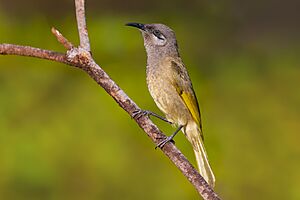Grey-eared honeyeater facts for kids
Quick facts for kids Grey-eared honeyeater |
|
|---|---|
 |
|
| Conservation status | |
| Scientific classification |
The grey-eared honeyeater (Lichmera incana) is a small bird from the honeyeater family. It is also called the dark-brown honeyeater. You can find this bird in Vanuatu and New Caledonia, which are islands in the south-west Pacific Ocean. Sometimes, people call it the silver-eared honeyeater, but there's another bird with that name in New Guinea.
Contents
What Does the Grey-eared Honeyeater Look Like?
The grey-eared honeyeater is about 13 to 17 centimeters long. Male birds are usually a bit bigger than females. Their feathers are mostly dull green-brown on top. Below, they are grey with a hint of olive green.
Their cheeks are a shiny silvery-grey, and the top of their head is dark grey. They have a black bill that is long and curves slightly downwards. Their legs and feet are blue-grey. Young birds, called juveniles, are lighter in color than adult birds and do not have the silvery cheeks.
These birds are quite noisy. They start calling even before the sun comes up! They have a harsh tchoo-tchoo-tchoo call. They also sing a pretty, warbling song.
Where Do Grey-eared Honeyeaters Live?
The grey-eared honeyeater is a common bird in most places where it lives. You can find them in lowlands and small hills. They live in many different places, like forests, scrub areas, mangrove swamps, and even gardens.
There are five different types, called subspecies, of the grey-eared honeyeater. One type, L. i. incana, lives on Grande Terre, which is the main island of New Caledonia. Other types live on the Loyalty Islands near New Caledonia or in Vanuatu.
How Do Grey-eared Honeyeaters Behave?
What Do Grey-eared Honeyeaters Eat?
Grey-eared honeyeaters look for food from the ground up to the tops of trees. They move from branch to branch, searching for flowers. They drink nectar from the flowers and also eat pollen.
They also enjoy eating insects and spiders. They search for these tiny creatures among leaves. Sometimes, they fly quickly into the air to catch insects. They might even hover in front of flowers or spider webs to find their next meal.
Reproduction and Life Cycle
The time when grey-eared honeyeaters have their babies is usually from October to February. The female bird builds a nest mostly from grass and plant fibers. She uses spider webs to hold the nest together. The nest is often built in the fork of a branch in a tree or a bush.
The female lays two eggs. These eggs are white with a few reddish spots. The parents then sit on the eggs to keep them warm, which is called incubating, for about 14 days. Once the young birds hatch, they are fed insects and spiders. They leave the nest after about 12 days.


